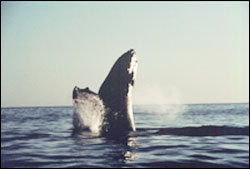Reviewing scientists say proposed conservation measures unlikely to help whales

Humpback Whale breaching
Ocean sanctuaries are unlikely to fully protect whales, say three independent scientists charged by the International Whaling Commission (IWC) with reviewing their sanctuary program to manage whale populations.
In a Policy Forum article forthcoming in the January 28 issue of the journal Science, Arizona State University marine biologist Leah Gerber, Duke University marine biologist K. David Hyrenbach, and University of Victoria geographer Mark Zacharias argue that the current sanctuary plan is not scientifically sound because it does not sufficiently consider the migratory behavior of most whale species, does not factor in threats to whales besides whaling, and would be difficult to evaluate once implemented.
“The scientific basis for the sanctuary program is not really valid,” said Gerber.
“The sanctuaries are arbitrary in their boundaries because they were designed largely based on political considerations rather than by scientific criteria. Our analysis shows that the science-based harvesting plan known as the Revised Management Procedure (RMP) would be much more effective in encouraging growth of whale populations.”
Models developed by the group show that the RMP would likely result in significant increases in whale populations over a hundred years, regardless of whale behavior. If whales are largely not migratory in their behavior, then the sanctuary plan would work as well or better, but if at least 50 percent of a given population migrates, then the sanctuary plan would be significantly less effective. If most whales are migratory, then virtually no growth would occur in whale populations under the sanctuary plan.
The sanctuaries designated by the IWC are four large areas in the South Atlantic, South Pacific, Indian and Southern Oceans. While the areas are large, the scientists believe that the whales that the sanctuaries are meant to protect also spend part of the year in areas where they would be vulnerable to capture by whalers.
“There is a growing body of literature on marine reserves and empirical evidence about the effects of reserves from around the world. There is a general consensus among scientists that these are a really useful approach to conserve endangered species and to recover over-exploited populations. More recent research suggests cases in which they are or are not effective,” said Gerber. “If we are going to create these sanctuaries, let’s use some data about the distribution and habitat requirements for these species to identify their potential efficacy.”
The article proposes that a refined program of whale conservation that uses both the RMP and a sanctuary plan “designed to protect populations of whales during certain time periods or throughout their entire ranges” would be the most effective approach to maintaining and building populations once commercial whaling starts again. The scientists also propose that “scientific permit whaling” be terminated, since the practice effectively amounts to unregulated whaling and is thus counter-productive to whale conservation.
“We really can’t establish an ecological baseline for whales if there are no untouched populations. And without this science, there is no way to really effectively manage whales and whaling,” Gerber said.
Media Contact
More Information:
http://www.asu.eduAll latest news from the category: Ecology, The Environment and Conservation
This complex theme deals primarily with interactions between organisms and the environmental factors that impact them, but to a greater extent between individual inanimate environmental factors.
innovations-report offers informative reports and articles on topics such as climate protection, landscape conservation, ecological systems, wildlife and nature parks and ecosystem efficiency and balance.
Newest articles

Retinoblastoma: Eye-Catching Investigation into Retinal Tumor Cells
A research team from the Medical Faculty of the University of Duisburg-Essen and the University Hospital Essen has developed a new cell culture model that can be used to better…

A Job Well Done: How Hiroshima’s Groundwater Strategy Helped Manage Floods
Groundwater and multilevel cooperation in recovery efforts mitigated water crisis after flooding. Converting Disasters into Opportunities Society is often vulnerable to disasters, but how humans manage during and after can…

Shaping the Future: DNA Nanorobots That Can Modify Synthetic Cells
Scientists at the University of Stuttgart have succeeded in controlling the structure and function of biological membranes with the help of “DNA origami”. The system they developed may facilitate the…



